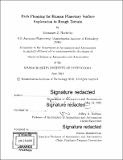| dc.contributor.advisor | Jeffrey A. Hoffman. | en_US |
| dc.contributor.author | Norheim, Johannes J | en_US |
| dc.contributor.other | Massachusetts Institute of Technology. Department of Aeronautics and Astronautics. | en_US |
| dc.date.accessioned | 2018-11-28T15:42:34Z | |
| dc.date.available | 2018-11-28T15:42:34Z | |
| dc.date.copyright | 2018 | en_US |
| dc.date.issued | 2018 | en_US |
| dc.identifier.uri | http://hdl.handle.net/1721.1/119309 | |
| dc.description | Thesis: S.M., Massachusetts Institute of Technology, Department of Aeronautics and Astronautics, 2018. | en_US |
| dc.description | Cataloged from PDF version of thesis. | en_US |
| dc.description | Includes bibliographical references (pages 127-131). | en_US |
| dc.description.abstract | This thesis discusses updates to the Surface Exploration Traverse Analysis and Navigation Tool(SEXTANT) that allowed it to be applied in a real EVA path planning and navigation scenario for the first time since pioneering work was done on such a tool back in 2001. SEXTANT has been ported from MATLAB to Python, which in contrast is an open-source and non-proprietary programming language, an effort which was motivated by NASAs BASALT (Biologic Analog Science Associated with Lava Terrains) campaign. This thesis also discusses its integration with a larger EVA planning, execution, and analysis environment developed at NASA Ames: xGDS(exploration Ground Data Systems) in contrast to the standalone tool that previously existed. It also details the performance of SEXTANTs path planning capability for the first time and introduces new parameters that allow for the trade of time complexity and optimality of the path. The thesis also outlines a method that can overcome problems that were encountered with rough terrain captured in high resolution digital elevation maps(DEM). Next, the thesis discusses results and lessons learned from using SEXTANT during two BASALT deployments in basaltic terrains in Idaho and Hawaii. Finally it goes into details on interfaces that were built to complement SEXTANT: a web-based interface for both planning and navigation purposes, and the Holo-SEXTANT Augmented Reality (AR) navigation solution. The first was used as the primary navigation method for the analog astronaut crew during one of the deployments, while Holo-SEXTANT was used by the analog crew as a technology demonstrator during two simulations, and several times out-of-simulation in the same environment. | en_US |
| dc.description.statementofresponsibility | by Johannes J. Norheim. | en_US |
| dc.format.extent | 131 pages | en_US |
| dc.language.iso | eng | en_US |
| dc.publisher | Massachusetts Institute of Technology | en_US |
| dc.rights | MIT theses are protected by copyright. They may be viewed, downloaded, or printed from this source but further reproduction or distribution in any format is prohibited without written permission. | en_US |
| dc.rights.uri | http://dspace.mit.edu/handle/1721.1/7582 | en_US |
| dc.subject | Aeronautics and Astronautics. | en_US |
| dc.title | Path planning for human planetary surface Exploration in rough terrain | en_US |
| dc.type | Thesis | en_US |
| dc.description.degree | S.M. | en_US |
| dc.contributor.department | Massachusetts Institute of Technology. Department of Aeronautics and Astronautics | |
| dc.identifier.oclc | 1062277751 | en_US |
